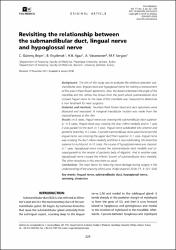Revisiting the relationship between the submandibular duct, lingual nerve and hypoglossal nerve

Göster/
Erişim
info:eu-repo/semantics/openAccessAttribution 3.0 United Stateshttp://creativecommons.org/licenses/by/3.0/us/Tarih
2018Yazar
Beşer, Ceren GünençErçakmak, Burcu
Ilgaz, Hasan Barış
Vatansever, Alper
Sargon, Mustafa Fevzi
Üst veri
Tüm öğe kaydını gösterÖzet
Background: The aim of the study was to evaluate the relations between submandibular duct, lingual nerve and hypoglossal nerve for making a reassessment of this area in fresh frozen specimens. Also, the distance between the angle of the mandible and the vertical line drawn from the point where submandibular duct crossed lingual nerve to the base of the mandible was measured to determine a new landmark for neck surgeons. Materials and methods: Fourteen fresh frozen head and neck specimens were dissected and evaluated. A marginal mandibular incision was made from the mastoid process to the chin.
Results: In 8 cases, lingual nerve was crossing the submandibular duct superiorly; in 5 cases, lingual nerve was crossing the duct infero-medially and in 1 case it was parallel to the duct. In 1 case, lingual nerve subdivided into anterior and posterior branches. In 2 cases, 2 parallel submandibular ducts were found and the lingual nerve was crossing the upper duct from superior. In 1 case, lingual nerve was crossing the duct infero-medially and then it was subdividing into branches superior to mylohyoid. In 12 cases, the course of hypoglossal nerve was classical. In 1 case, hypoglossal nerve crossed the submandibular duct medially and coursed parallel to the tendon of posterior belly of digastric. And in another case, hypoglossal nerve crossed the inferior branch of submandibular duct medially. The other structures in this area were as usual.
Conclusions: The main factor for reducing nerve damage during surgery is the understanding of the anatomy of this area.
Kaynak
Folia MorphologicaCilt
77Sayı
3Koleksiyonlar
Aşağıdaki lisans dosyası bu öğe ile ilişkilidir:


















